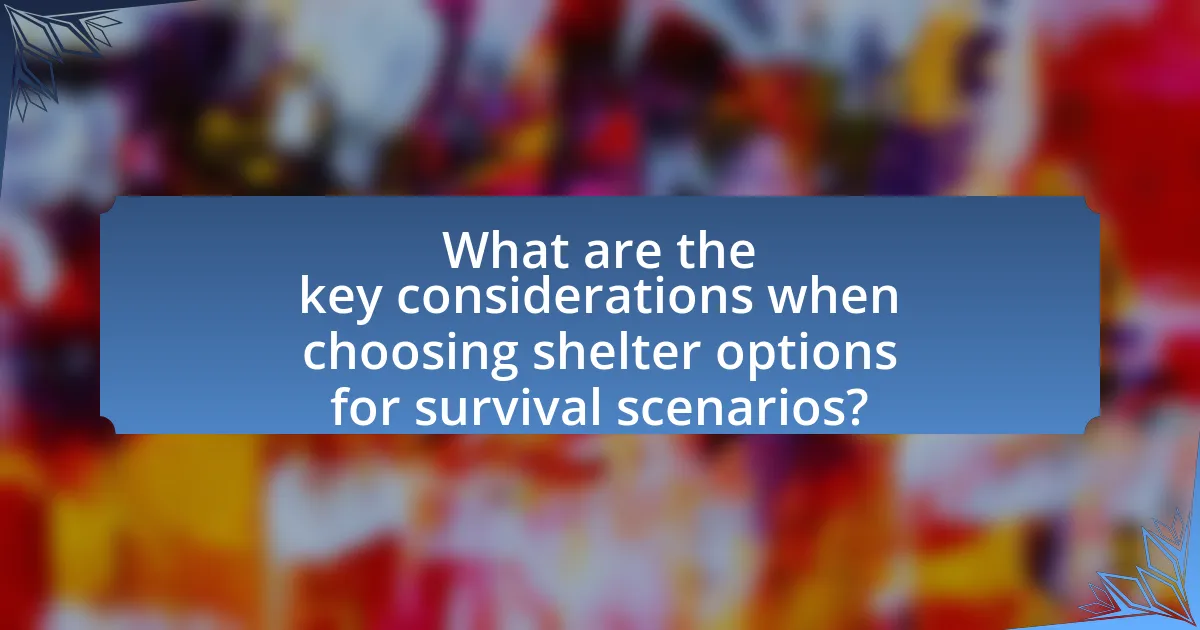The article focuses on the critical aspects of selecting appropriate shelter options for survival scenarios. Key considerations include location, materials, insulation, and protection from environmental elements, which are essential for ensuring safety and comfort. The influence of environmental factors, personal needs, and the number of occupants on shelter design is examined, along with the advantages and disadvantages of various shelter types, such as natural, improvised, and constructed shelters. Additionally, the article highlights the importance of evaluating safety, accessibility, and structural integrity when making shelter choices, as well as common mistakes to avoid in the decision-making process.

What are the key considerations when choosing shelter options for survival scenarios?
The key considerations when choosing shelter options for survival scenarios include location, materials, insulation, and protection from elements. Location is critical as it should be safe from hazards like flooding or predators, while also providing access to resources such as water and food. The materials used must be durable and suitable for the environment; for example, natural materials like branches and leaves can be effective in forested areas. Insulation is essential to maintain body heat in cold conditions, and the shelter should be designed to protect against wind, rain, and extreme temperatures. Historical survival scenarios, such as those documented in wilderness survival guides, emphasize these factors as vital for increasing chances of survival.
How do environmental factors influence shelter selection?
Environmental factors significantly influence shelter selection by determining the suitability and safety of various locations. For instance, temperature extremes can dictate the need for insulation or ventilation in shelters, while precipitation levels influence the choice of waterproof materials. Additionally, terrain features such as proximity to water sources, elevation, and natural barriers can affect accessibility and protection from elements. Research indicates that animals and humans alike often select shelters based on these environmental cues to enhance survival, as seen in studies of animal behavior where species adapt their nesting sites according to climate and habitat conditions.
What types of environments require different shelter designs?
Different environments require specific shelter designs to address their unique challenges. For instance, arctic environments necessitate insulated shelters to retain heat and withstand extreme cold, while desert environments require structures that provide shade and ventilation to combat high temperatures. Additionally, tropical environments demand shelters that can withstand heavy rainfall and high humidity, often incorporating raised platforms to prevent flooding. Each of these designs is informed by the environmental conditions, ensuring safety and comfort for inhabitants.
How do weather conditions affect shelter durability and comfort?
Weather conditions significantly impact shelter durability and comfort by influencing material integrity and thermal regulation. For instance, extreme temperatures can cause materials like wood to warp or metal to corrode, reducing the shelter’s lifespan. Additionally, heavy rainfall can lead to water infiltration, compromising structural stability and creating a damp environment that affects comfort. Research indicates that shelters designed for specific climates, such as those with proper insulation for cold weather or ventilation for hot climates, enhance occupant comfort and prolong durability. For example, a study by the National Institute of Standards and Technology found that well-insulated structures in cold climates can reduce heating costs by up to 50%, demonstrating the importance of weather-appropriate design in maintaining both durability and comfort.
What personal factors should be considered in shelter choice?
Personal factors to consider in shelter choice include individual needs, health conditions, family size, and personal skills. Individual needs dictate the type of shelter that will provide adequate protection and comfort, while health conditions may require specific accommodations, such as accessibility features. Family size influences the space required, ensuring that all members can be safely housed. Personal skills, such as construction or survival skills, determine the feasibility of building or maintaining a shelter. These factors collectively guide the decision-making process to ensure that the chosen shelter meets the unique requirements of the individual or group.
How does the number of occupants impact shelter size and type?
The number of occupants directly influences both the size and type of shelter required. Larger groups necessitate more spacious shelters to accommodate sleeping arrangements, communal areas, and storage for supplies, while smaller groups can utilize compact shelters such as tents or small cabins. For instance, a family of four may require a minimum of 200 square feet for comfortable living, whereas a group of ten might need at least 400 square feet to ensure adequate space for daily activities and privacy. Additionally, the type of shelter may vary; larger groups might opt for more permanent structures or multi-room tents, while smaller groups can effectively use portable options like tarps or single-room tents.
What skills and resources do individuals have that affect shelter options?
Individuals possess various skills and resources that significantly influence their shelter options, including practical skills, financial resources, and social networks. Practical skills such as construction, carpentry, and outdoor survival techniques enable individuals to build or adapt shelters effectively. Financial resources determine the ability to access permanent housing or purchase materials for temporary shelters. Social networks provide support in finding shelter options, whether through shared housing arrangements or community resources. For instance, a study by the Urban Institute highlights that individuals with strong social ties are more likely to secure stable housing, demonstrating the critical role of social capital in shelter accessibility.

What are the different types of shelters available for survival scenarios?
The different types of shelters available for survival scenarios include natural shelters, improvised shelters, and constructed shelters. Natural shelters utilize existing features in the environment, such as caves, overhangs, or dense foliage, to provide protection from the elements. Improvised shelters are created using available materials like branches, leaves, or tarps, allowing for quick assembly in emergency situations. Constructed shelters involve building a more permanent structure, such as a lean-to, debris hut, or snow cave, which can offer enhanced durability and insulation. Each type of shelter serves the primary purpose of providing safety and comfort in adverse conditions, making them essential for survival.
What are the advantages and disadvantages of natural shelters?
Natural shelters offer several advantages and disadvantages. The primary advantage is their availability and integration into the environment, providing immediate protection from elements such as rain, wind, and sun. For example, caves, overhangs, and dense foliage can serve as effective barriers against harsh weather conditions. Additionally, natural shelters often require minimal construction effort, allowing for quick setup in survival situations.
Conversely, the disadvantages include potential safety risks, such as the presence of wildlife or unstable structures. Natural shelters may also lack adequate insulation, leading to exposure to cold temperatures. Furthermore, they can be difficult to locate in unfamiliar terrain, which may hinder survival efforts. Overall, while natural shelters can be beneficial in survival scenarios, they also present significant risks that must be carefully considered.
How can caves and overhangs provide protection?
Caves and overhangs provide protection by offering natural shelter from environmental elements such as rain, wind, and extreme temperatures. These formations create a barrier that shields inhabitants from harsh weather conditions, reducing exposure to the elements. For instance, caves maintain a more stable internal temperature compared to the outside environment, which can be crucial for survival in extreme climates. Additionally, the structural features of caves and overhangs can deter predators and provide a safe space for resting or sleeping, enhancing overall safety. Historical evidence shows that early humans utilized caves for shelter, demonstrating their effectiveness in providing protection throughout human history.
What are the risks associated with using natural shelters?
Using natural shelters poses several risks, including exposure to environmental hazards, wildlife encounters, and structural instability. Environmental hazards such as flooding, falling branches, or landslides can compromise safety, particularly in areas prone to severe weather. Wildlife encounters, including snakes or insects, can lead to injuries or disease transmission. Additionally, natural shelters may lack adequate protection from the elements, leading to hypothermia or heat exhaustion. Structural instability is a concern, as natural formations may collapse or fail to provide sufficient support. These risks highlight the importance of assessing the environment and understanding the limitations of natural shelters in survival scenarios.
What are the benefits of building improvised shelters?
Building improvised shelters provides essential protection from environmental elements, enhancing survival chances in adverse conditions. These shelters can be quickly constructed using available materials, allowing individuals to adapt to their surroundings efficiently. For instance, in survival situations, such as natural disasters or wilderness emergencies, the ability to create a shelter can significantly reduce exposure to harsh weather, thereby preventing hypothermia or heat-related illnesses. Additionally, improvised shelters can offer psychological comfort and a sense of security, which are crucial for maintaining morale during challenging circumstances.
What materials are best for constructing temporary shelters?
The best materials for constructing temporary shelters include tarps, tents, bamboo, and natural materials like leaves and branches. Tarps are lightweight, waterproof, and easy to set up, making them ideal for quick shelters. Tents provide more structure and protection from the elements, while bamboo is strong and flexible, suitable for building frameworks. Natural materials, such as leaves and branches, can be used for insulation and camouflage, enhancing the shelter’s effectiveness. These materials are commonly used in survival scenarios due to their availability and practicality.
How can one ensure stability and safety in improvised shelters?
To ensure stability and safety in improvised shelters, one should prioritize strong structural support and secure anchoring. Utilizing sturdy materials such as logs, branches, or tarps can enhance the shelter’s integrity. For instance, a well-constructed A-frame or lean-to design distributes weight evenly and resists wind. Additionally, anchoring the shelter to the ground with stakes or heavy rocks prevents it from being displaced by environmental factors. Research indicates that shelters built with a solid foundation and reinforced corners can withstand adverse weather conditions, thereby increasing occupant safety.

How can one effectively evaluate and choose the right shelter option?
To effectively evaluate and choose the right shelter option, one must assess the specific needs based on environmental conditions, available resources, and personal safety requirements. Evaluating environmental conditions involves analyzing factors such as weather patterns, terrain, and potential hazards, which directly influence shelter effectiveness. For instance, in cold climates, a shelter must provide insulation and protection from wind, while in wet environments, it should offer waterproofing and drainage.
Additionally, available resources, including materials for construction and proximity to water sources, play a crucial role in determining the feasibility of a shelter option. For example, using natural materials like branches and leaves can be effective in forested areas, while urban settings may require utilizing existing structures.
Personal safety requirements, such as protection from wildlife or security from human threats, must also be considered. A well-chosen shelter not only meets basic survival needs but also enhances overall safety and comfort. Therefore, a comprehensive evaluation of these factors leads to informed decision-making in selecting the most suitable shelter option for survival scenarios.
What criteria should be used to assess shelter options?
To assess shelter options, criteria should include safety, accessibility, environmental protection, resource availability, and structural integrity. Safety ensures the shelter protects occupants from threats such as wildlife or extreme weather. Accessibility refers to how easily individuals can reach the shelter, especially in emergencies. Environmental protection involves the shelter’s ability to shield occupants from elements like rain, wind, and cold. Resource availability assesses proximity to water, food, and firewood, which are essential for survival. Structural integrity evaluates the durability and stability of the shelter, ensuring it can withstand environmental stresses. These criteria are essential for making informed decisions in survival scenarios.
How does accessibility influence shelter choice?
Accessibility significantly influences shelter choice by determining how easily individuals can reach and utilize a shelter during survival scenarios. Factors such as proximity to resources, transportation routes, and the physical ability of individuals to navigate to the shelter directly impact the decision-making process. For instance, a study by the National Institute of Standards and Technology highlights that shelters located near essential resources like water and food sources are preferred, as they reduce the time and energy required to access these necessities. Additionally, shelters that are easily accessible for individuals with disabilities or those carrying heavy loads are more likely to be chosen, as they ensure safety and practicality in emergency situations.
What role does the intended duration of stay play in shelter selection?
The intended duration of stay significantly influences shelter selection by determining the type of shelter that meets the needs of the individual or group. For short-term stays, individuals may opt for temporary shelters like tents or tarps, which are easy to set up and dismantle. In contrast, for long-term stays, more permanent structures such as cabins or reinforced shelters are preferred, as they provide better protection and comfort over extended periods. Research indicates that the choice of shelter is closely linked to the expected duration of occupancy, with longer stays necessitating considerations for durability, insulation, and resource availability.
What are some common mistakes to avoid when selecting a shelter?
Common mistakes to avoid when selecting a shelter include overlooking location, neglecting structural integrity, and failing to consider environmental factors. Choosing a location that is prone to flooding or falling debris can jeopardize safety; therefore, assessing the terrain and potential hazards is crucial. Additionally, selecting a shelter with weak materials or poor construction can lead to collapse or inadequate protection from the elements. Lastly, ignoring environmental factors such as temperature, wind direction, and wildlife can result in discomfort or danger. These mistakes can significantly impact the effectiveness and safety of the shelter in survival scenarios.
How can one avoid underestimating the importance of location?
To avoid underestimating the importance of location, one should conduct thorough research on the geographical and environmental factors that influence survival. Understanding aspects such as climate, natural resources, and potential hazards in a specific area is crucial. For instance, a study by the National Oceanic and Atmospheric Administration highlights that locations prone to natural disasters, like floods or wildfires, can significantly impact survival outcomes. By analyzing these factors, individuals can make informed decisions about shelter options that enhance their chances of survival in various scenarios.
What are the pitfalls of neglecting to consider safety and security?
Neglecting to consider safety and security can lead to severe consequences, including increased vulnerability to threats and potential harm. When individuals fail to prioritize safety, they expose themselves to risks such as theft, violence, or natural disasters, which can result in injury or loss of life. For instance, a study by the National Institute of Justice found that homes without security measures are three times more likely to be burglarized. Additionally, inadequate safety planning can lead to psychological distress, as individuals may feel unsafe in their environment. Overall, overlooking safety and security compromises personal well-being and can have lasting negative impacts on individuals and communities.
What practical tips can help in choosing the right shelter for survival?
To choose the right shelter for survival, prioritize location, materials, and environmental conditions. Selecting a location away from hazards like flooding or falling debris is crucial; for instance, high ground is preferable in flood-prone areas. Use available materials such as branches, leaves, or tarps to construct a shelter that provides insulation and protection from the elements. Additionally, consider the climate; for example, in cold environments, a shelter that retains heat is essential, while in hot climates, ventilation is key. These factors are supported by survival training programs, which emphasize the importance of situational awareness and resourcefulness in shelter selection.


